Ryan Hall's Blog, page 151
July 11, 2017
U.S. Runners Are Getting Slower And Health May Be To Blame
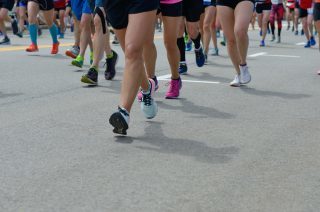
A new study has found that American runners are getting slower—in the 5K, 10K, half marathon and marathon. Led by Jens Jakob Andersen and Ivanka Andreeva Nikolova from RunRepeat.com, the team looked at data from 24,763,389 race results between 1996 to 2016.
According to NPR, based on their research, results from 2015 and 2016 are the slowest in history. Andersen and Nikolova were quick to dispel three possible answers: 1) the increase in women racers; 2) the boost in participants who choose to sign up and walk the race versus run; 3) slow runners are getting slower.
So if these aren’t the case, what is? They believe it is the decline in health among Americans.
The authors told NPR:
“We correlated the average race finish time with each of those parameters and saw clear trends. These correlations proved to be strong, 99 percent statistically significant, consistent, plausible, coherent and replicable in different circumstances.
Nevertheless, these are just correlations. We cannot infer from the national statistics the health condition of the race runners. Is it deteriorating or improving? Also, in no way we argue that these are the only possible explanations and reasons for the observed effect.”
NPR hopes the team will repeat the study among runners in other countries—especially those without rising health epidemics such as obesity—to find out if this is truly the answer.
RELATED: 2016 U.S. Marathons and Halfs Report Reveals Participation is Declining
The post U.S. Runners Are Getting Slower And Health May Be To Blame appeared first on Competitor.com.
Drawings To Begin For 2018 Big Sur Marathon Entries

Photo: Big Sur International Marathon
On April 29, 2018, runners will once again descend upon the Pacific Coast Highway in northern California to run the Big Sur International Marathon. If you don’t already have an entry secured for this bucket-list race, there is still a chance to take in those stunning ocean views come race day thanks to a series of random drawings taking place in late July and early August this year.
There are three categories runners can enter under: Groups & Couples, Individuals and Last Chance Drawing.
GROUPS & COUPLES: From July 15-24, this category is for groups of two to 15 people to enter and want to participate only if the entire group is chosen. Results will be announced on July 26.
INDIVIDUALS: From July 29 to Aug. 7, this category includes Loyalty runners (those who have finished one or more Big Sur Marathons), Local runners (residents of Monterey County) and “Bucket List” First Timers (those who have never finished the Big Sur International Marathon) and individuals are allowed to enter in multiple categories if eligible. Results from this drawing will be announced from Aug. 8-12.
LAST CHANCE DRAWING: You can register from Aug. 19-25 for this final opportunity to enter for a chance to receive a slot in the 2018 race. This is open to any individual including those not selected in an individual category above and results announced Aug. 26.
Runners who are chosen in the drawings will receive a notification via email with a limited window to complete their registration. If selected, prices for the 2018 Big Sur International Marathon are $175 for U.S. runners, $200 for international entrants and $160 for Monterey County residents. There is no fee to enter any of the drawings.
“We are flattered and humbled by the interest in running our marathon from runners around the world,” said race director Doug Thurston in a press release announcing the drawings. “This entry process, refined over the last few years, provides several options for participants to experience the incredible beauty of our course and the hospitality of our community.”
Full information, including how to register as a charity runner for an entry, can be found at official race website bsim.org.
RELATED: 10 North American Marathons That Are Vacation-Worthy
The post Drawings To Begin For 2018 Big Sur Marathon Entries appeared first on Competitor.com.
Lawsuit Between Lululemon And Under Armour Over Patent
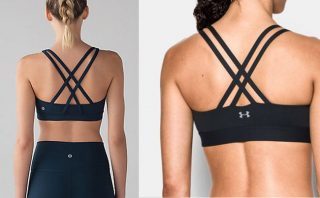
Photo: Lululemon (left) and Under Armour (right)
Last week, Lululemon filed a lawsuit against Under Armour in Delaware federal court with a claim that Under Armour is infringing on patents and trade dress rights for three sports bras that Lululemon has held since 2014.
According to Fashion Network, the bras in question include Under Armour’s Eclipse/Shape Low Impact, On the Move and Printed Strappy sports bras. Of the Eclipse/Shape Low Impact sports bras specifically, Lululemon notes the interweaving straps are a copy of its Energy bra (shown in the photo above).
“While Lululemon has made seasonal updates to its Energy bra, the crisscrossed straps for the light support bra are supposedly recognizable as a Lululemon bra to frequently purchasing consumers in the sports bra market,” writes Fashion Network. “Lululemon sells its model for $52. Under Armour’s Eclipse sells for $40.”
Under Armour has not yet responded to the lawsuit from Lululemon.
The post Lawsuit Between Lululemon And Under Armour Over Patent appeared first on Competitor.com.
adidas Partners With Female Artists To Design Shoes For Each State

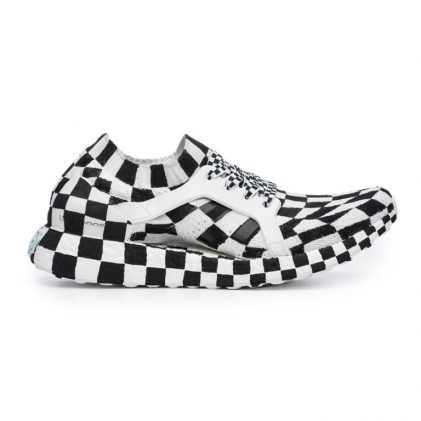




adidas has turned their women’s UltraBOOST X running shoe into true works of art.
In partnership with lifestyle website Refinery 29, adidas commissioned 11 celebrated female artists to design one-of-a-kind shoes representing all 50 states for their BOOST the Nation collection. The artists took their inspiration from each state’s landscape, culture and landmarks. The results are vivid, diverse and unique, turning the UltraBOOST X shoes into a fashionable yet functional showcase of state pride.
“The custom sneakers designed for women by women celebrate the diversity and creativity of this country, while intersecting sport and art in a unique and shareable way,” said Hallie Johnston, SVP, Client Services & Strategy, Branded Content at Refinery29.
The limited edition shoes are only available through a digital silent auction on adidas.com. The bids on certain shoes are climbing steadily—Pennsylvania is up to $2,000 while Ohio is at $1,000. However many others are still under $200. The auction ends today, July 11, so if you want to to be the only runner to own your state shoe, put in a bid ASAP.
All of the funds raised through the auction will be donated to Women Win. The global organization helps to empower young girls with leadership skills and address gender equality through sport. There is an option to donate to the cause even without winning a shoe.
“As a brand that walks the line between sport and creativity, we saw the triple white silhouette as a blank canvas full of possibilities to collaborate with powerful and expressive women in a way that would celebrate differences and highlight the unique characteristics that unite us,” said Alexa Andersen, U.S. category director for women’s running at adidas, in a statement.
To see all 50 pairs of custom UltraBOOST X shoes and place a bid, head to adidas.com.
RELATED: adidas Makes Running Shoes From Recycled Ocean Plastic
The post adidas Partners With Female Artists To Design Shoes For Each State appeared first on Competitor.com.
Miles Are Coming—The Best Places To Run In Westeros

Image: HBO.com
(Disclaimer: The following is a nonsensical farce. That said, it contains spoilers through “Game of Thrones” Season 6. So if you haven’t binged your way through, considered yourself warned).
Winter is here and the miles are coming!
We couldn’t be more excited about the Season 7 premier of HBO’s “Game of Thrones” on Sunday, July 16. When we left off, Daenerys was steaming toward Westeros, Cersei was roasting marshmallows over the Sept of Baelor and John Snow was declared King in the North. Plus, the R+L=J theory finally panned out. Oh yeah, Bran is time jumping, so that’s cool.
To mark the occasion of the new season, we thought it would be fun to pick out some of our favorite potential running spots in Westeros and build some races around them. The difficulty is that Westeros is fictional—and GoogleMaps got mad when I tried to navigate from “home to Deepwood Motte.” So we’re estimating distances from a post Winteriscoming.net did a couple of years ago. We’re avoiding Essos, because who really wants to run through hundreds of miles of horse manure in the Dothraki Sea? And we’re not going North of the Wall because, duh, White Walkers.
So enjoy this running trip around Westeros!
The King’s Landing Fun Run
This race is available in a 5K, 10K, half and full marathon. There’s also a nude walking option. Rumor has it Queen Cersei (long may she reign) will pace the bare-bottomed walkers with a direct route from the Sept to the Red Keep. The local tradition is to yell “shame” and throw iron-rich vegetables to help walkers keep up their strength.
The longer distances will take you by beautiful Blackwater Bay (I hear they are adding a triathlon for next year!), up and down the Street of Sisters, Flower, Silk and Steel before finally ending at a giant splash down pool into the Mud Gates. Wine stops are available at each mile except in Flea Bottom, where you can pick up a bowl of brown.
As a bonus, all of the Kingsguard are expected to show up and cheer you on at the end. And if you’re a little tired, maybe Jaime Lannister can lend you a hand.
The Bloody Gates Trail Run
This ultra is not for the faint of heart. It’s 70 miles up a narrow path before finally coming to an end at The Eyrie (we’ve received word that the archers will stand down for the weekend … you’re welcome). Runners will have to negotiate technical terrain through the Mountain of the Moon while also coping with thinning oxygen as they climb several thousand feet. If you’re in the back of the pack and you see them closing the gates, whatever you do, don’t yell “Hold the door.” That’s just bad form.
But those who finish will be treated to a great feast in the High Hall of the Arryns before spending the night recovering in a luxurious Sky Cell with all of its scenic views. It’ll be slow going on your way down the trail the next day. But if you’re in a hurry, word is that Lysa Arryn knows a quicker way down.
Winterfell-to-The-Wall Ragnar Relay
Get a group of friends together, because you’re not going to want to go it alone on this one. It’s about 650 miles via The King’s Road from Winterfell to Castle Black. As we know, winter is here (remember, The Citadel sent out white ravens last season), so appropriate cold-weather gear will be necessary.
But runners will also be treated to splendid scenery as they run by Long Lake and cross The Last River en route to The Gift—the land that was given to the Night’s Watch thousands of years ago by Bran the Builder (who really might be Bran floating through time????). Mole’s Town might be a little seedy. But it’s a place to crash and the people are kind … at least the ones who weren’t eaten by Thenns.
Run With Your Dog at The Dreadfort
Not a lot is known about this particular castle in The North. But hey, the Boltons seem like they are totally dog people. So why not bring your pooch for a brisk Northern run along the Weeping Water? It’s well known that the late Roose Bolton did not imbibe, so don’t expect a post-race beer. Also, stay away from the basement. It smells pretty bad down there. Many have said it’s been known to Reek.
Dorne Wine/Beach Run
Let’s get out of the cold and catch some rays! The gardens of Sunspear are gorgeous and the castle is surrounded on three sides by water. So you might as well bring the whole family and make it a beach getaway weekend. Per a wiki of fire and ice, it’s three leagues—about 10 miles— from the Palace of Water Gardens to Sunspear. And after a tough race, is there anything better than a nice goblet of Dornish red as the sun sets. Just be on the lookout for kissing Sand Snakes.
The Ultimate Tour de Westeros Ultra
If you believe this particular post, Westeros is a giant 5,600K from South to North, or 3,479 miles. For perspective, GoogleMaps says it’s 3,120 miles from San Diego (Competitor magazine’s HQ) to the State of Maine.
An ultrarunner can accomplish this feat in fewer than 50 days. Let’s assume you aren’t an ultrarunner. You are going to want to stop along the way and partake in local fare, like sipping Dornish wine and taking a swim in The Riverlands. And of course you have to stop for a selfie with your battle hammer at The Trident.
If you want to walk it, that’s going to take some time. But you’d still finish before “The Winds of Winter” is released.
RELATED: 5 Star Wars Quotes That Can Be Perfect Running Mantras
The post Miles Are Coming—The Best Places To Run In Westeros appeared first on Competitor.com.
July 10, 2017
Professional Runner Chased By Bears While On A Run In Maine
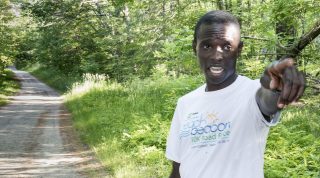
Photo: Russ Dillingham/Sun Journal
Professional runners have to face many challenges and compete against tough opponents. But they don’t normally train to outrun bears. However one elite runner did just that last week.
Moninda Marube, a professional runner originally from Kenya, embarked on his training run early last Wednesday morning on the Whitman Spring Road Trail in Auburn, Maine, less than an hour north of Portland. The 38-year-old had planned to run 18 miles. Six miles in, he heard a rustling in the trees. Two black bears began to cross the trail, making their way to a nearby lake. Marube stopped in his tracks, but unfortunately, the bears had spotted him.
“I had to make a quick decision,” said Marube in a video for the Lewiston-Auburn Sun Journal. “Climb up this tree or run back or run to the lake. Of course I don’t swim.”
Luckily, Marube had passed a vacant house not far up the trail.
“My initial instinct told me the best thing for you to do is just run to that house probably to save yourself there because I was not about to fight them,” he recalled.
As Marube turned to run, the bears began to chase after him. His legs carried him to the house, where he was able to open a door to a screened in porch. With only the flimsy screen for protection, Marube waited as the bears sniffed around the house before chasing each other away. He ran away in the opposite direction when he determined the path was clear. In total, Marube estimates he was on the porch for about 10 minutes.
An hour later, he finally made it to the home of Dan Campbell, the University of Maine at Farmington track coach. Marube arrived in the United States seven years ago, and was taken in by Campbell, becoming a member of his extended family. Marube is also currently a student at UMaine Farmington.
One day prior to his bear incident, Marube finished 2nd at the Bridgton, Maine 4 on the Fourth road race, where he was only chased by humans. He is also very involved with raising awareness and funds for charity. In 2015, he ran from Maine to California to raise awareness for human trafficking.
Asked if he had any advice for other runners who encountered bears, Marube suggested running later in the day.
“Please don’t be here at 5 o’clock in the morning. That’s all I can say. If you can wait, then wait.”
He also plans to invest in some pepper spray, just in case the bears ever cross his path again.
RELATED: Black Bear Startles Runners And Joins 10-Miler In Colorado
The post Professional Runner Chased By Bears While On A Run In Maine appeared first on Competitor.com.
July 7, 2017
Charitable Race Donations: How to Politely Ask (And Decline)

The running community is phenomenal when raising money for those in need with charitable donations.
Not only are there countless races dedicated to charities, but many runners also use their own goal races as a way to draw attention and collect contributions to causes that are personally important to them.
Still, it can be uncomfortable asking family, friends and colleagues to support a fundraising goal. It can also be awkward on the other end: what if you need or want to say no?
We asked a few etiquette experts to share advice on how to handle these potentially sticky situations.
Be selective with whom you ask
“If you don’t know the names of their kids or the colleges they went to, or the names of their pets, don’t ask,” says Patricia Rossi, an etiquette coach and author of Everyday Etiquette: How to Navigate 101 Common and Uncommon Social Situations. “You want to be fairly close with people.”
But it is okay to ask running acquaintances if you know they have a particular interest in that cause or organization.
What about your bosses? Assuming you are on good terms and know a few personal details about them, it’s fine to ask.
But Rossi says, “Ask the boss last in case he/she tells you can’t ask other people” in the office.
It’s not always about what you say but how you say it
Approaching people in person, or by phone, email or through social media is acceptable, experts say. If you are sending an email or posting to social media, choose your words carefully.
“The tone should be upbeat and positive with a brief, yet moving explanation about the organization and why you are supporting it,” says Lisa Gaché, founder of Beverly Hills Manners, an etiquette coaching company. “Let your recipients know that even the smallest donation makes a significant difference.”
Even if you haven’t received donations yet, express gratitude for people’s consideration of your request.
Rossi says if you are posting to Facebook, address your message to family and friends and avoid using the word “money.” Requesting a “contribution” or “donation” is more appropriate, she says.
RELATED: Charity Running: Follow The Rule of Thirds To The Finish Line
Set limits
Don’t approach friends or relatives who may be struggling financially. You also shouldn’t hit up the same people for contributions more than once a year, Rossi says.
“Not unless it’s your sister, brother, parents or your three best friends,” she says.
If you are raising money for more than one cause in a year, Gaché suggests having separate contact lists for each.
“Never double dip your requests,” she says.
Say “no” politely
If you receive a request, it’s acceptable to decline, but do it gently. You don’t necessarily have to provide a reason, but a sincere explanation could prevent the person from feeling offended, experts say.
Rossi notes that it takes a lot of courage for some people to seek donations, so be kind.
“You could say, ‘I’ve already made a commitment to that charity or cause, but thank you for asking,’” she says. “You want to end with, ‘Thank you for including me.’’’
You could also politely decline by saying you already gave to your charitable causes this year.
If you don’t have money to give, take a light-hearted approach, Rossi suggests.
“You can just say: ‘Times are tight. I shouldn’t have gone to that Drake concert or that wine tasting,’” she says. “Humor levels everything.”
Gaché says if you can’t contribute financially, you may want to offer to be a race volunteer or show your support in another way.
RELATED: Don’t Even Think About Crowdfunding Your Race Costs
The post Charitable Race Donations: How to Politely Ask (And Decline) appeared first on Competitor.com.
The Actual Healthy Benefit You’ll Get From Weighing Yourself

When it comes to the scale and weighing yourself, there are many opinions on whether or not it is actually necessary. Some people live or die by the number; some people ignore it. Of course, we know that your weight doesn’t define your health; even if you are considered overweight by medical standards, you can still be perfectly healthy. Whatever your final decision on the merits of the scale, if you are a runner, you may not want to throw away the device for good for another reason that may surprise you
The Importance of Proper Hydration
As the summer months are already underway throughout the country, dehydration is the big topic, especially in the fitness world. Though some runners choose to take the summer months off, those with a fall marathon on the schedule are already underway with speed work and long runs, despite the intense heat.
Taking into consideration that 75 percent of Americans are chronically dehydrated, it is even more important to make sure you are taking in enough fluids when working out. Don’t expect to just be able to chug water after your run and replace all of the fluids you lost; unfortunately proper hydration doesn’t work like that.
RELATED: 6 New Products To Keep You Hydrated All Day Long
Of course, hydration isn’t just a topic for the summer months. It is important to remember that you can become dehydrated even if it is cold outside. However, you will need to be prepared to take in more water during intense physical activity and in hotter climates.
The Benefit Of Weighing Yourself
Here is where your scale comes into play: If you weigh yourself before and after exercise, you can estimate how much fluid you lost on a run so you can properly rehydrate your body.
According to the American College of Sports Medicine (ACSM), it is best to do this weigh in first thing in the morning after urinating, without any clothes on. The second measurement should be taken after exercise. From there, you can estimate how much fluid was lost as you sweat.
Based on the percentage of your body weight change, you can then know just how dehydrated you may be. The ACSM provides the following guidelines:
Percent Body Weight Change
Well Hydrated | -1 to +1%
Minimal Dehydration | -1 to -3%
Significant Dehydration | -3 to -5%
Serious Dehydration | > -5%
Getting Enough Fluids
You of course want to drink water before, during and after a workout and, at times, may want to add in a sports drink to replace lost electrolytes. The ACSM advises that if your workout is under an hour, you can fuel simply with water (3-8 fluid ounces of water every 15- 20 minutes) but if your workout is greater than an hour, a sports drink should be used (3-8 fluid ounces of a sports beverage every 15-20 minutes).
RELATED: Are Calories In Sports Drinks A Cause For Concern?
After a workout, use your weigh-in to determine how much water or sports drink you should refuel with. Here, the ACSM advises you “drink 20-24 fluid ounces of water or sports beverage for every one pound lost.”
If you choose to not weigh yourself on a daily basis because of your relationship with the scale, that is perfectly fine. However, here is one instance where knowing the number can directly affect your overall wellbeing. Maybe keep it stored away for days you work out, simply to make sure you are well hydrated and taking proper measures to stay healthy.
The post The Actual Healthy Benefit You’ll Get From Weighing Yourself appeared first on Competitor.com.
How Many Weeks Do You Really Need To Train For A Marathon?
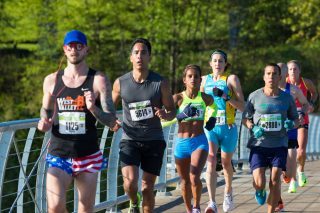
The marathon is a difficult distance—there’s no doubt about that. At 26.2 miles, it is considered the most difficult road race because of its sheer length.
That distance creates more muscle trauma (including your heart!), higher levels of fatigue, and greater damage to the endocrine system than shorter races. But while this is all temporary, a challenging race like a marathon should be approached in a methodical, strategic way to ensure that injuries are kept to a minimum and the chances for success are maximized.
Unfortunately, a lot of runners sabotage their efforts by rushing their training. And rushed training is risky training!
Depending on your fitness level, goals and ability, you’ll need between 12 and 20 weeks to prepare for the challenges of racing 26.2 miles.
Let’s find out where you are within that range.
“I’m a beginner!”
Those with a relatively low fitness level need more time to train for a marathon—and that does not mean just beginner runners. Even a highly trained competitive marathoner needs more time to prepare for 26.2 miles if they have taken an extended time off from running.
The commonality between a beginner and an out-of-shape competitive runner is their low fitness level.
If you can run about 8-10 miles for your long run, you’ll need between 18-20 weeks to adequately prepare to run a marathon. This ensures that there is enough time to carefully build your overall mileage and long run to a level that will support a marathon on race day. Runners at this level should focus on finishing the race and not on a specific time goal.
But what if you’re running less than 8 miles for your longest run of the week? In that case, you’re not ready to train for a marathon. Focus on a half marathon and come back in 4-5 months.
RELATED: Are You Making These Marathon Training Mistakes?
“I’m an Intermediate Runner!”
Runners with a medium level of fitness are those who are comfortable running about 25-35 miles per week with a double-digit long run. If that describes you, dedicate between 14-18 weeks of training solely to the marathon.
Intermediate runners are not as worried about getting their long run up to about 20 miles before the race. There’s plenty of time for that. Instead, the goal now becomes performance—or in other words, a specific time goal.
These runners will first build their long run distances up to about 20 miles. But then their long runs can alternate between 18-20 miles, while shorter long runs can include some goal marathon-pace running.
Here’s an example progression of long runs over the last four weeks of peak marathon training:
20 miles – easy pace
16 miles – first 12 miles at easy pace, last 4 miles at goal marathon pace
20 miles – easy pace
18 miles – first 13 miles at easy pace, last 5 miles at goal marathon pace
This approach prioritizes both general endurance and marathon-specific endurance. It will help you run as fast as possible on race day.
RELATED: Training Plan: 4 Months To A Faster 26.2
“I’m an Advanced Runner!”
Runners with an advanced fitness level are comfortable running over 40 miles per week with a long run in the 12-15 mile range. Since they’re already in great shape, they don’t need as much time to specifically train for a marathon.
An effective training approach for this type of runner will include about 12-16 weeks of specific marathon training. The first half of the training program will help the athlete get up to 20 miles for their long run. The second half of the plan will include more pace-specific long runs.
Here’s an example progression of long runs over the last 6 weeks of peak marathon training:
20 miles – easy pace
18 miles –first 14 miles at easy pace, last 4 miles at goal marathon pace
21 miles – easy pace
20 miles – first 15 miles at easy pace, last 5 miles at goal marathon pace
18 miles – first 10 miles at easy pace, last 8 miles at goal marathon pace
You’ll see that for every ability level, the goals remain the same. Run more consistent long runs with an increasing amount of the volume at goal pace. The more advanced the runner, the more mileage and goal pace they can handle. And ultimately, the faster they’ll run.
No matter what type of marathoner you are, always work on your ability to run higher mileage. It will increase your workload capacity, which has the most direct impact on your race times.
Now lace up those shoes and start running long!
RELATED: Maintaining Your Speed During Marathon Training
The post How Many Weeks Do You Really Need To Train For A Marathon? appeared first on Competitor.com.
Special Olympics Athletes To Help Further OSU Research
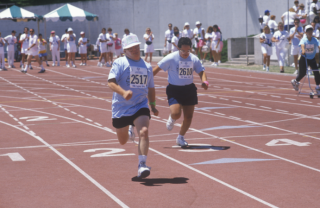
Photo: Joseph Sohm/ Shutterstock.com
This weekend, 2,000 Special Olympics athletes will compete in the Special Olympics Oregon Summer State Games. At the same time, they will be helping Oregon State University further research related to the health of people with intellectual disabilities. Oregon State is host of the the Summer State Games, where athletes participate in track and field, bocce, golf and softball.
Throughout the weekend, two special programs will be taking place at the same time: Healthy Athletes and Oregon Team Wellness.
The Healthy Athletes program provides free health screenings, where strength, flexibility, balance and endurance are tested on site. Athletes are later given a take-home program based on their results. The goal is to further improve and encourage participation in sports and recreational activities.
Oregon Team Wellness, presented by the Special Olympics Oregon, is designed for those with intellectual disabilities. The program incorporates incentives and rewards to reach benchmarks, with the ultimate goal of lifelong healthy choices and habits. Other states in the Northwest have adopted this program that started in Oregon.
“There still is this misconception that if you have a disability, then you cannot be healthy,” said Gloria Krahn, the Barbara Emily Knudson Endowed Chair in family policy studies at Oregon State University, in a press release. “I would’ve thought that after 25 years, we would be past some of that. Special Olympics is helping bring about that change.”
All the research and information gathered this weekend will go into one of the largest data sets for people with intellectual disabilities in the world.
RELATED: Brooks Announces Partnership With 2018 Special Olympic USA Games
The post Special Olympics Athletes To Help Further OSU Research appeared first on Competitor.com.
Ryan Hall's Blog
- Ryan Hall's profile
- 21 followers



